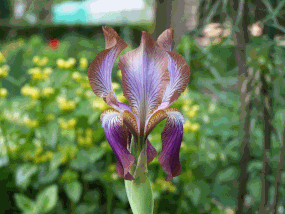Sun, Sun, Sun!
The location can decide on to be or not to be for all irises. If an iris clump produces few pedicals and the rhizomes only reach the average size, the plants oftenly lack direct blazing sunlight. Irises are absolute sunbathers. They are preferably exposed to sunlight from dawn till dusk in order to save enough power in their rhizomes. Only a few, not too common, wild species are adapted for less sun. If you want your irises to flourish in full bloom and grow, you should choose a place where they can absorb direct sunlight at least 6 hours a day. A sunny location also offers you the advantage to assess the quality of the flowers. Indeed, there are varieties whose flowers enormously lose substance when they are exposed to large temperature fluctuations and strong sunlight. If these varieties bloom in a shady location, they erroneously seem solid. Such sensitive varieties are not recommended and shouldn't even be brought into the garden.
When choosing a location, the competition with other plants has to be observed, too. Irises oftenly perish in a mixed planting, because high-growing plants cover and thus weaken them. So you should choose low-growing, less sprawling plants for a combination with irises. For exampel peonies, that left their place in bed for the rest of the year after withdrawing and don't multiply too much, are highly recommended. Delphinium hybrids can provide the bed with color once before and, after a cutback, one more time after the irises bloom. Furthermore small-flowered marigolds or rudbeckia and helenium varieties bring very good effects with irises. But it's always important to watch the bed and to avoid companion plants becoming too strong.
Soil
Irises are more or less divided into two large groups:
Drought-loving irises and moisture-loving irises.
As far as the ground for bearded irises is concerned, you should remember just one thing: drainage, drainage, drainage! Bearded irises endure various soil reactions and compositions with plenty
of perseverance. But if the soil is moist for a long period, it's quickly over with the big flower and the strong growth. A long period of rain on bad-drained soil is oftenly enough to make the
plants susceptible to rot and perish.
So pay attention on how quickly water drains on your beds. If there are a lot of puddles or the ground still holds much water after the rain, you should improve the drainage to deeper layers with the help of coarse sand and ensure that large amounts of water can flow away before completely penetrating the ground, for example with the help of slightly tilted beds.
Some bearded iris from the section of Hexapogones even need an absolute drought period in the summer.
Those who have very acidic soil in their garden should ameliorate the soil with a little bit of chalk. As a little rule of thumb, one can say that ground which is in the wettest times of the year mossy must be ameliorated before planting bearded irises. If you have a lot of rainfall and the ground longely stores water, it is advisable to turn to more moisture-loving irises. These are almost all beardless iris.

If bearded irises are in the right place and have the right soil, nothing can go wrong.

Hexapogones (here a regelia) need a drought in summer and have to be protected of too much moisture also in winter.










